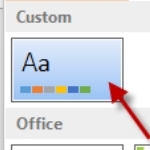
By Ellen Finkelstein
8 Steps to Add Branding to Your PowerPoint Presentations
When I do corporate training or public webinars, I usually ask attendees to submit a couple of slides. After covering basic principles of how to transform presentations (and the reasons behind those principles), I show makeovers of the submitted slides. The makeovers help people see how to use the principles on their own slides.
One of the principles that I don’t usually cover at first, but which comes up all the time in makeovers, is branding. A website is branded. A printed brochure is branded. But all too often, presentations use any old colors — whether the default or anything else. Part of the reason is that websites and brochures are designed by professional designers and presentations are often created by presenters who are anything but that.
Large companies do sometimes have professionally designed templates that match their branding but even then, in my experience, presenters often misuse or don’t use those templates, with sloppy results.
Why brand your presentation?
Branding is a big concept and is a way to encapsulate your company’s identity. One aspect of branding is the visual component, which can include:
- A logo
- A tagline
- Colors
- Fonts
- Illustration and photography style
- Graphic theme
A presentation that outsiders see represents your organization, so it should use your branding. Even for internal presentations, branding can create a sense of shared purpose among the audience members. Sales presentations often include some aspects of the potential customer’s branding, as well — usually just the logo and colors.
Just as a country’s flag is a way to rally citizen’s around the interests of a country, the visual aspects of branding help to rally employees around the interests of an organization.
How to add branding to a presentation
It isn’t hard to add branding to your presentations and save the results as a theme that you can use over and over. Here are the steps to take to add branding to a presentation in PowerPoint 2007 and 2010:
1. I usually start by taking a screenshot of the organization’s website. In Windows Vista, 7 and 8, you can use the Snipping Tool that comes with Windows. I save the image and insert it on a slide so I can refer to it.
2. Use a color picker program (also called an eyedropper) to get the exact colors from the website. I use ColorPic, but also like Pixeur. They’re both free, so try them both and see which one you like best. I write down the colors or copy them to a text box on a slide. (Pixeur makes it easy to copy the RGB color specifications to the Windows Clipboard.)
This post is excerpted with the permission of PowerPoint Tips.




